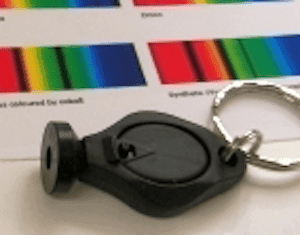
Product Review: GL SpectroLite
The GL SpectroLite is an inexpensive and easy-to-use tool that can help gemologists conduct spectroscope exams. Read our review to learn more.
2 Minute Read
Prism vs Diffraction Grating Spectroscopes
Spectroscopes come in two varieties: prism and diffraction grating. Each has its advantages and disadvantages.
Diffraction grating spectroscopes cost less than prism spectroscopes. However, their primary shortcoming is that the display is so dark you can’t get a reading on some stones.
Prism spectroscopes have a brighter display, and some have a calibrated scale. However, their spectrum is spread out unevenly. This makes it hard to read the red end.
Both spectroscopes are difficult to use. Prism spectroscopes have an adjustable light opening and a focusing control. It requires two hands to make these adjustments. To accomplish this, the stone needs to be in a fixed position. Most gemologists also prefer to attach a prism spectroscope to a stand. Diffraction grating spectroscopes are usually handheld. Not having to adjust the focus and light opening simplifies the process, but getting the scope, stone, and light source aligned is a little less easy. You need steady hands and a lot of patience to perform this task gracefully.
Aligning the Spectroscope, Gem, and Light
The most difficult part of using either spectroscope is aligning the instrument with the light coming out of the stone. Light doesn’t pass…
Related Articles
Gemology Reference Books: Reviews
How to Build Pocket Crossed Filters for Gemstone Testing
How to Build a Multipurpose Microscope Stage for Gems
Dichroscope Guide for Gemologists
Latest Articles
800 Years of Mogok: A Celebration in Tenuous Times
What is the Average Gemstone Faceting Yield?
Pyroxmangite Value, Price, and Jewelry Information
How to Identify Emerald Simulants and Synthetics
Never Stop Learning
When you join the IGS community, you get trusted diamond & gemstone information when you need it.
